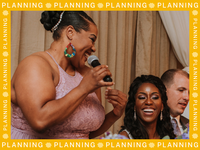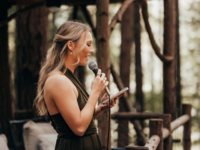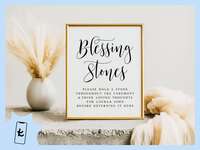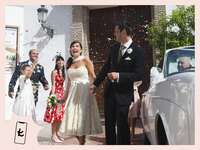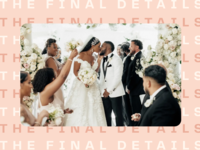Let's Get Back to Basics: What Are Wedding Vows?
Figuring out what you will or won't say in your marital promises can feel daunting. If you're stuck, take a step back and consider the question: "What are wedding vows?" This knowledge will give you a better appreciation for the custom, a traditional template when you're writing your vows and guide you as you prepare your ceremony script. Keep reading to get the inside scoop on the origin, history and meaning of wedding vows, including how the declaration of intent and pronouncement comes into play, so you can be more than ready when it's time to say "I do."
Everything you need to know about wedding vows: What Are Wedding Vows? | Origin and History | How They Work | What's the Declaration of Intent? | What's the Pronouncement?
What Are Wedding Vows? The Definition
For those wondering how to define wedding vows, it's pretty simple. Traditional wedding vows are the promises to-be-weds make to each other during the wedding ceremony or private exchange. What's promised between each couple differs based on their culture, religion and personal preferences.
Wedding Vows Meaning
One of the most common wedding vow promises across cultures and religions is to declare your lifelong commitment to your spouse, witnessed by your friends, family and, if you're religious, your god. This not only creates a strong bond between you and your partner, but your loved ones as well. Your guests act as a physical representation of a community ready to support you throughout your marriage. And yes, wedding vows can be intense, romantic and emotional pledges, but they can also be funny and full of laughter. So if you want your wedding vows to have a sillier energy, go for it.
Origin and History of Wedding Vows
Even though these promises have a Christian context, historians have yet to find evidence of them in the Bible. Instead, they believe the origin of wedding vows (or at least the traditional Westernized version) is The Book of Common Prayer by Thomas Cranmer, Archbishop of Canterbury. In the first edition, published in 1549, Cranmer takes medieval Catholic customs, like the Sarum rite, and translates them from Latin to English. The Sarum rite is where we get the wedding vows we use today. Here is the 1552 version from The Book of Common Prayer: "I [Name] take thee [Name] to be my wedded wife, to have and to hold from this day forward, for better, for worse, for richer, for poorer, in sickness and in health, to love and to cherish, till death us depart, according to God's holy ordinance: And thereto I plight thee my troth."



How Do Wedding Vows Work?
Professional vow writers and couples always recommend speaking from the heart when you're crafting your marital pledges. We suggest starting with an intimate moment that brought you and your partner where you are today and finishing with a passionate closing line. If you're still unsure how to write vows, use our printable wedding vow template and check out some wedding vow examples from real couples to guide and inspire you. Remember, everyone's vows are different and can shift based on writing style, ceremony structure and officiant's advice.
What's the Declaration of Intent in a Wedding?
While searching for wedding vows' history and meaning you've probably run into some wedding declaration of intent vs. vows discussions. Here's everything you need to know without getting too confused: The purpose of the declaration of intent is for both partners to state that they're entering the marriage of their own free will and want to be each other's spouse. The declaration of intent typically involves the officiant asking each partner if they'll take the other person as their "lawfully wedded spouse" and then both people are expected to confirm with "I do" or "I will." People also often wonder if the declaration of intent is before or after vows. In a secular ceremony, officiants usually ask the couple to share their vows and then complete the declaration of intent. Finally, some states legally require couples to include the declaration in the ceremony script. Before finalizing your ceremony order and wording, talk with your officiant about whether that's a law in the state you're marrying in.
What's the Pronouncement in a Wedding Ceremony?
The wedding pronouncement is when the officiant proclaims to everyone at the ceremony that you and your partner are officially married. This is when the officiant says the familiar speech, "By the power vested in me by the state of [marrying location], I now pronounce you [wife and wife/husband and husband/husband and wife]! You may now kiss the [bride/groom]!" Where you're getting married determines if the pronouncement is required, so ask your officiant about this while discussing ceremony logistics.





